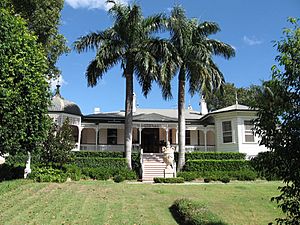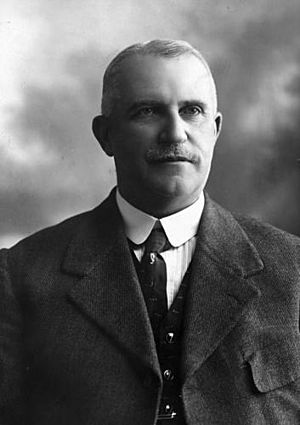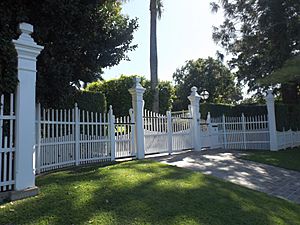Windermere, Ascot facts for kids
Quick facts for kids Windermere, Ascot |
|
|---|---|

Windermere, 2007
|
|
| Location | 14 Sutherland Avenue, Ascot, Queensland, Australia |
| Design period | 1870s–1890s (late 19th century) |
| Built | c. 1886–1930s |
| Official name: Windermere | |
| Type | state heritage (landscape, built) |
| Designated | 21 October 1992 |
| Reference no. | 600048 |
| Significant period | 1880s-1930s (fabric) 1880s-1910s (historical) |
| Significant components | gate – entrance, fence/wall – perimeter, trees/plantings, tennis court, residential accommodation – main house |
| Lua error in Module:Location_map at line 420: attempt to index field 'wikibase' (a nil value). | |
Windermere is a beautiful old house in Ascot, Queensland, Australia. It's a special type of home called a villa, built around 1886. This house is so important that it's listed on the Queensland Heritage Register. This means it's protected because of its history and unique design.
Contents
The Story of Windermere House
Windermere was built on land that was first owned by a man named James Sutherland in 1855. He was a pastoralist, which means he owned large areas of land for raising livestock. James Sutherland owned a lot of land in the area and even in the city.
Before the current Windermere was built, there might have been a smaller house called "Hillside House" on the site. This first house was rented out for a few years.
Building a New Home
It's believed that the original house was taken down, and a new, grander house was built around 1886. This new house was for James Sutherland's daughter, Ruth, and her husband, John George Appel. John Appel was a solicitor, which is a type of lawyer. Some people think a famous architect named Richard Gailey might have designed the house, but we don't know for sure.
John Appel's Life and Work
John Appel married Ruth Sutherland in 1879. Soon after, he became a solicitor. After about ten years, he stopped being a lawyer and became a pastoralist, like his father-in-law. He also became a very important person in politics.
John Appel was a member of the Hamilton Shire Council from 1890 to 1908. He was even the chairman twice! Later, when Hamilton became a municipality, he was the mayor two times. He also had farms near Nerang and was part of the Nerang Shire Council.
In 1908, John Appel became a member of the Queensland Legislative Assembly, which is like being a member of parliament for Queensland. He worked in different government roles, including Secretary for Mines and Public Works. He then became the Home Secretary in 1909, a job he kept until 1915.
Later Owners of Windermere
After the Appels, Windermere had several different owners.
- From 1918, Charles Frederick White owned the house for five years, but he rented it out.
- In 1923, George Kermode Jeffrey and his wife Lillian bought the house. During the 1920s, some parts of the house were changed. For example, a separate kitchen and servants' area were removed, and a verandah was enclosed.
- From 1928 to 1967, Dr. Ellis Murphy and his wife Mary lived in Windermere. Dr. Ellis Murphy was a well-known doctor at the Brisbane General Hospital and a professor at the University of Queensland. He was even knighted in 1967 for his important work!
Windermere was sold a few more times after 1967. In the 1980s, some parts of the house were updated, like the front stairs and some bathrooms. In 1994, new owners did a lot of work to improve the gardens, the back of the house, and the inside.
What Windermere Looks Like
Windermere is a large, beautiful house made of timber planks called chamferboard. It has roofs made of corrugated iron. The house sits on a small hill, set back from the street, and has lovely gardens with old, tall trees. The house and its trees add a lot to the look of the Ascot area.
House Design and Features
Even though parts of the house have been changed over the years, the main part of the house and its front entrance still look much like they did when it was first built. The house has a "public" area for guests and formal events, and a "private" area for the family. There are also two newer sections at the back.
Windermere has wide verandahs on the south and east sides. These connect to a small, open building called a gazebo in the corner. The house also has several parts that stick out, called bays, with unique shapes.
Beautiful Details
The outside of Windermere has many pretty details. The large bays have special roofs and decorative timber brackets. The verandahs have fancy cast iron railings, timber posts, and carved wooden screens called spandrels. The gazebo has a special curved roof. The front entrance has a wide cedar door with glass panels on the sides and above.
Inside, the house has high timber ceilings, timber floors, and timber walls. It has beautiful cedar wood details, windows with etched and coloured glass, and fancy plaster decorations on the ceilings. The hallways have lovely cedar arches. Many windows have frosted glass with patterns, and some have coloured glass. There are also French doors that open onto the verandahs.
Gardens and Gates
The gardens around Windermere have some very old and large trees, including Bunya Pines and camphor laurels. The front of the property on Sutherland Avenue has a beautifully decorated fence with strong gateposts.
Why Windermere is Special
Windermere was added to the Queensland Heritage Register on 21 October 1992. This means it's recognized as an important historical place for several reasons:
- It shows how Queensland's history developed: Windermere is a great example of the large, fancy homes built for important families during the 1880s, a time when Queensland was growing fast.
- It's a good example of its type: It perfectly shows the main features of a grand family home from that time period.
- It's beautiful: The house and its old trees make the Ascot area look very nice, and the inside of the house has many beautiful details.
- It's connected to important people: Windermere has strong links to John Appel, a well-known Queensland politician and pastoralist, and Dr. Ellis Murphy, a famous doctor in Brisbane.



